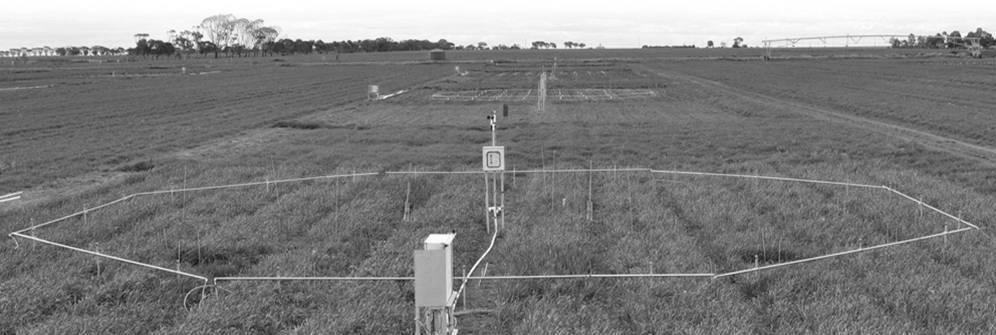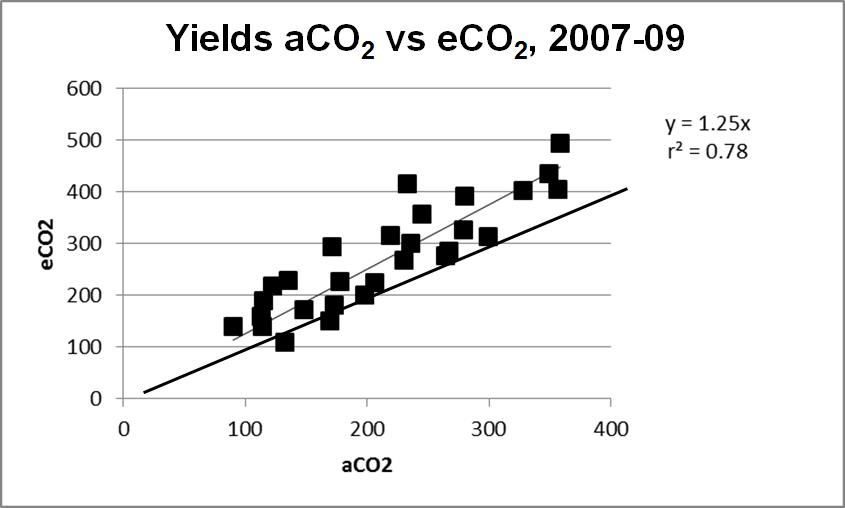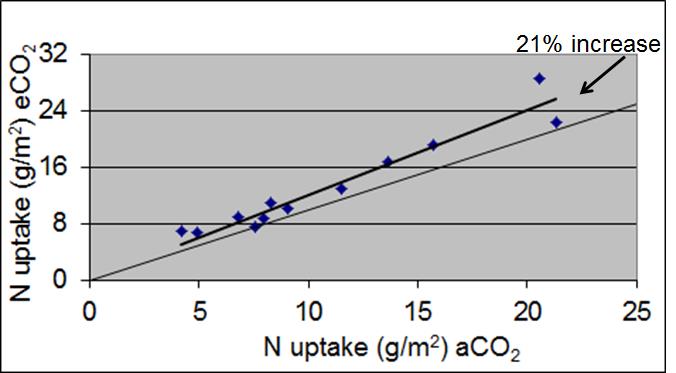Positive crop adaptations to climate change
Author: Glenn Fitzgerald (Victorian Department of Economic Development, Agriculture Research Division) | Date: 09 Feb 2016
Background
Methodology
In AGFACE, CO2 levels are increased around crops grown under field conditions in open octagonal rings, which consist of horizontal metal pipes that emit CO2 (Figure 1) into the wind. The wind then blows the CO2 across the crops within. These horizontal rings are raised on supports to sit just above the crop canopy during crop growth. A central sensor measures the concentration and a computer maintains the central CO2 concentration at 550ppm, taking into account wind speed and direction. Different segments of the rings are turned on and off as wind direction changes, allowing the CO2 emitted to be blown across the ring uniformly. The experiments are fully randomised and blocked such that half the ‘rings’ have elevated CO2 and half are at current ambient concentrations.

Figure 1: AGFACE ring – TraitFACE.

Results and discussion
Yields and water use

Figure 3: Yield simulation due to eCO2. Mean increase was 26% for the years 2007-09.
Another feature of eCO2 is increased water use efficiency (WUE). In AGFACE, WUE has been shown to increase by about 25 per cent compared to current ambient conditions. This occurs because the plant does not have to keep the stomatal pores on its leaves open as long to capture CO2 since the concentration is greater. Thus, there is less loss of water from the leaves through transpiration. Since crops are larger under eCO2 they may use more water to support their growth. Thus, the actual water use of crops may be similar to current crop production. Results from AGFACE show a net reduction in water use of about six per cent from 2007-09.
Testing traits
Another trait tested was transpiration use efficiency (TUE) comparing the Hartog and Drysdale cultivars (Tausz-Posch et al., 2012). Given that plants under elevated CO2 are expected to be more water use efficient, one of the hypothesis was that the advantage conferred from the TUE trait in Drysdale would be less effective under future elevated CO2 concentrations. However, the opposite was found. Drysdale yielded 19 per cent more under elevated CO2 but only 2 per cent more under current ambient concentrations compared to Hartog, which is a parent of Drysdale but does not have the TUE trait. Thus, continued research into more transpiration efficient cultivars should remain fruitful.
Other traits such as rooting and nitrogen use efficiency are currently be tested in AGFACE.
Grain quality
Elevated CO2 decreases the amount of N in plant leaves, which in C3 type plants (most efficient at photosynthesis in cool, wet climates) like wheat and legumes, leads to reductions in grain protein. The decrease in wheat measured in AGFACE ranged from one to 15 per cent, depending on environment and variety. Increasing yields may drive this to some extent, causing an ‘N dilution’ effect but elevated CO2 also causes physiological changes in the plant that appears to be related to certain genes being expressed differently (Buchner et al. 2015). The mean protein reduction in wheat across all seasons from AGFACE data is six per cent. Although this doesn’t seem like much, a pilot analysis using receival site data from farms across Victoria has shown this resulted in 35 per cent of all grain downgraded in quality to the next lowest class in the year this was tested.
Another consequence of reduced wheat grain protein is changes in bread quality (Panozzo et al., 2014). The changes in protein amount and possibly composition lead to changes in elasticity and other factors important in bread making. Not all varieties are affected equally however, but some show large changes in volume, shape and other important characteristics (Figure 4).

Besides changes in grain protein, there are analogous reductions in grain micronutrients, particularly iron (Fe) and zinc (Zn), both important in human nutrition (Myers et al., 2014). This reduction in micronutrients has been referred to as ‘hidden hunger’ and in AGFACE wheat grain Zn and Fe concentrations reduced by, on average, five and 10 per cent respectively. It is currently unclear why these reductions occur but this is being researched. Although reduction in micronutrients may not affect people with access to abundant food, increasing population may lead to millions of people, principally in Africa, suffering from Zn deficiency (Myers et al., 2015).
Legumes do not tend to show reductions in grain protein because they have a separate mechanism for acquiring N from soil microbes. In AGFACE, field peas showed a slight reduction in grain protein, but in production terms the effect was small (Bourgault et al., in preparation).
Pests
It is generally poorly understood what the effect of elevated CO2 is on different pests and disease. Barley Yellow Dwarf Virus (BYDV) is a pathogen in wheat which causes serious damage and decreased yield and is spread by an aphid vector. The results of a study in AGFACE have shown that the damage caused by the virus will increase under elevated CO2 (Trebicki et al., 2015). BYDV titre in elevated CO2 wheat leaves increased by about 37 per cent. Although the reasons for this increase in virus amount in the plants are currently unknown, it has been observed that aphids tend to feed more on plants grown under elevated CO2, increasing the chances of spreading the virus from infected aphids. The reason for this is that since plants have less leaf tissue N, aphids need to feed more, which they do my inserting their stylus into leaves more often. Adaptation may require breeding for resistant lines but more research into understanding the mechanisms of virus increases is required.
Belowground processes

Figure 5: N uptake increase of 21 per cent due to elevated CO2 (eCO2) versus ambient CO2 (aCO2).
Heat shocks
In 2009, there was an extended heat wave near anthesis across the south eastern wheat belt that saw temperatures over 32° C for about eight days. In that year, heat wave effects were ameliorated under elevated CO2 as shown by reductions of 31 and 54 per cent in screenings and 10 and 12 per cent larger kernels (for Horsham and Walpeup sites, respectively) compared to ambient. Greatest yield stimulations occurred in the elevated CO2 late sowing treatments and heat stressed treatments, for those treatments supplied with more water. It appears that under elevated CO2, if there is sufficient water near anthesis, plants can maintain yields by maintaining kernel size.
Computer modelling
Computer simulation is an important tool to synthesize results from AGFACE with other information, particularly information that is not easily obtained from field studies, such as landscape changes in temperature and rainfall. Integration with economic data will also be valuable to understand farm level impacts. Integrating these data can provide a predictive tool to understand a more complete picture of the impacts of changing climate on crop production and what can be done to adapt. Research is currently on-going to synthesise the years of data from AGFACE to provide a glimpse into future impacts of elevated CO2 under a range of possible environments. This will provide information for development of adaptation strategies for trait selection and management practices (such as sowing time and N management) to take the most advantage of elevated CO2.
Conclusion
- Increases growth and yields in wheat, peas and other crops by on average 25 per cent but with a large range from 0 to over 70 per cent
- Decreases protein content in wheat grain by up to 15 per cent
- Increases water use efficiency by on average 25 per cent, but water use may only reduce slightly
- Decrease bread loaf volume and other quality factors
- Increases the incident of barley yellow dwarf virus
- May reduce the impacts of heat waves near anthesis.
Useful resources
Australian Grains Free Air CO2 Enrichment website
Buchner P, Tausz M, Ford R, Leo A, Fitzgerald GJ, Hawkesford MJ, Tausz-Posch S. (2015) Expression patterns of C- and N-metabolism related genes in wheat are changed during senescence under elevated CO2 in dry-land agriculture. Plant Science 236:239-249.
Myers S, Zanobetti A, Kloog I, Dietterich L, Sartor K, Hasegawa T, Raboy V, Nelson R, Leakey A, Ottman MJ, Tausz M, Fitzgerald G, Seneweera S, Schwartz J. (2014) Rising CO2 threatens human nutrition. Nature, 510:139-143.
Myers S, Wessells KR, Kloogg I, Zanobetti A, Schwartz J (2015) Effect of increased concentration of atmospheric carbon dioxide on the global threat of zinc deficiency: a modelling study. The Lancet Global Health 3(10): e639-e645.
Panozzo JF, Walker CK, Partington DL, Neumann NC, Tausz M and Fitzgerald GJ. (2014) Elevated carbon dioxide changes grain protein concentration and composition and compromises baking quality. A FACE study. J Cereal Science 60:461-470.
Tausz-Posch S, Dempsey RW, Seneweera S, Norton RM, Fitzgerald G, Tausz M. (2015) Does a freely tillering wheat cultivar benefit more from elevated CO2 than a restricted tillering cultivar in a Mediterranean-type cropping system? European Journal of Agronomy, 64:21-28.
Tausz-Posch S, Seneweera S, Norton R, Fitzgerald G, Tausz M (2012). Can a wheat cultivar with high transpiration efficiency maintain its yield advantage over a near-isogenic cultivar under elevated CO2? Field Crops Research 133:160–166.
Acknowledgement
Funding for this work was provided through the GRDC Project DAV00137 and their support gratefully acknowledged.
Contact details
Glenn FitzgeraldAgriculture Research Division
Victorian Department of Economic Development, Jobs, Transport and Resources
03 5362 2111
glenn.fitzgerald@ecodev.vic.gov.au
GRDC Project Code: DAV00137,
Was this page helpful?
YOUR FEEDBACK
